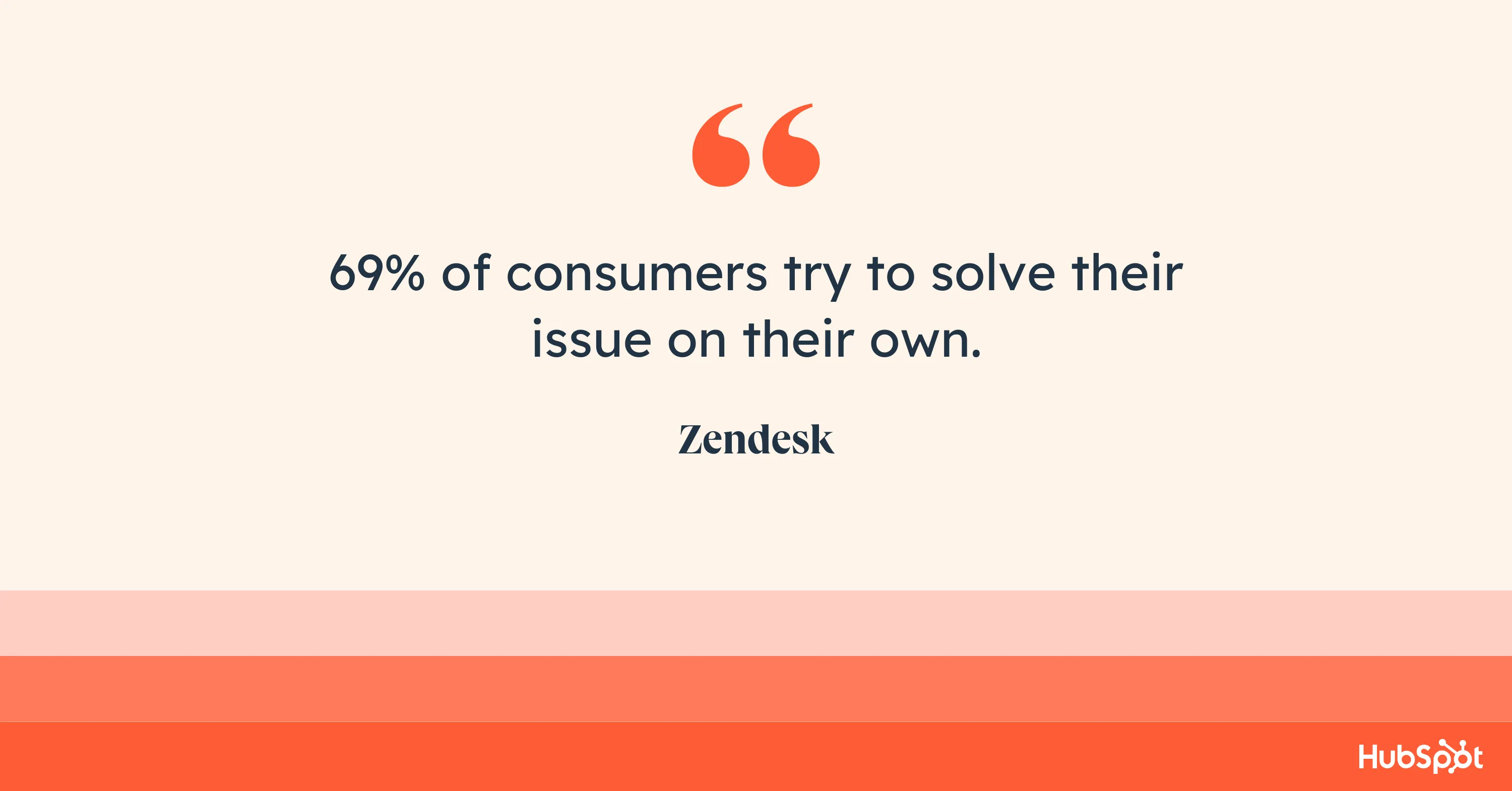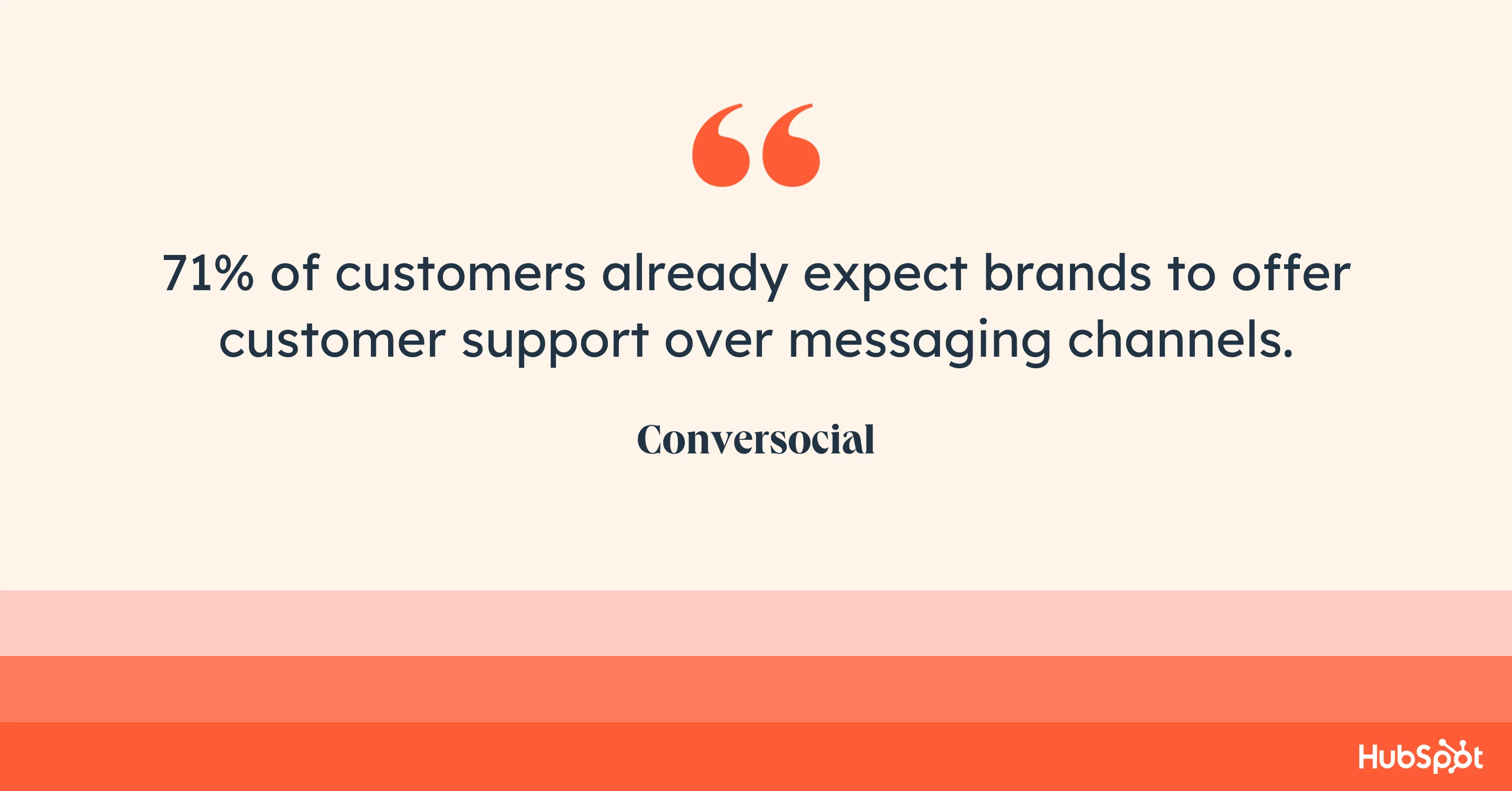Customers today expect the world, and they deserve it. By keeping up with customer service trends, you can ensure you’re meeting — and exceeding — expectations. And yes, it really is non-negotiable if you want your business to succeed in today’s highly competitive landscape.
Personally, I place a lot of weight on the quality of a company’s service and will allocate my money and loyalty accordingly. If you want to gain repeat customers, investing in top-tier customer experience is necessary.
→ Download Now: The State of Customer Service [Free Report]
Why should you take my advice? Because I worked on HubSpot’s Support Team from 2015 to 2017 before starting my journey as a professional musician, I have firsthand experience in the field. From the beginning, it struck me that HubSpot placed tremendous emphasis on the support team as a critical aspect of the business. And to this day, I believe that HubSpot’s investment in its support team is a substantial contributing factor to the business's success.
Read on to discover the customer service trends you can’t afford to miss out on in 2024.

The State of Customer Service Report
Unlock essential strategies for exceeding customer expectations and driving business growth in a competitive market.
- Exclusive insights from worldwide CRM leaders
- Analysis of modern customer behaviors
- Closer look at the AI opportunity in CRM
- Strategies for staying agile in 2024 and beyond
Download Free
All fields are required.

2024 Customer Service Trends
1. Use customer service as a vehicle for business growth.
73% of business leaders report that there is a direct link between their customer service and overall business performance. Additionally, 64% of business leaders say customer service positively impacts their growth.
As a result, businesses are increasing their investment in customer service to ensure customers are satisfied with their experience. I experienced this firsthand as a member of HubSpot Support.
During my tenure, HubSpot invested in the support team significantly so we could continue to provide top-tier customer service as the company grew. I believe this is a critical factor in the company’s continued success.
2. Customers want a personalized experience.
When someone reaches out to your team, they want to be treated like a person, not a number. They want to feel like their case is important and that your rep cares deeply about solving their issue.
It shouldn't feel like your team applies a one-size-fits-all approach to every customer interaction. Since every support case is different, you should treat each with a personalized approach. When I worked in support, my teammates and I would provide tailored service based on customer-specific needs. This allowed customers to feel heard and supported.
Keeping detailed notes on customers' challenges was essential for providing the context for personalized service, but above all, cultivating an empathetic approach to service was the key to providing customized solutions for each customer, in my experience.
Consumers are highly likely to purchase exclusively from brands that show they understand them.
If a customer asks you to do something you don‘t normally do, you should be flexible enough to adapt and meet their needs anyway. This is something I practiced often in my previous role. I regularly received queries technically outside customer service’s scope, but our team was trained to solve them for the customer regardless.
For example, customers sometimes contacted me with design-related questions. Despite not being a designer, I drew on HTML and CSS training to assist to the best of my ability. Often, I could repair a line of code or provide design consultation that delighted the customer.
Sometimes, I didn’t have the expertise required to help and had to refer the customer to another team member, but customers always appreciated me going above and beyond in an earnest attempt to assist.
3. Businesses are prioritizing customer experiences.
Since customers have more power over the buying process, more businesses prioritize customer experience over other acquisition strategies. In fact, 63% of companies are spending more time prioritizing the customer experience.
-1.webp) Customer experience is the holistic perception the customer has with your brand, not just with support. Exceptional support is critical to customer experience, but you want to optimize all touchpoints your customer has with your company. That can include your website, marketing correspondence, customer success, social media, packaging, onboarding, and more. It can even include experiential marketing efforts.
Customer experience is the holistic perception the customer has with your brand, not just with support. Exceptional support is critical to customer experience, but you want to optimize all touchpoints your customer has with your company. That can include your website, marketing correspondence, customer success, social media, packaging, onboarding, and more. It can even include experiential marketing efforts.
With more businesses shifting their focus to customer experiences, customer expectations are also rising. If your business isn't prioritizing customer experience, you risk failing to meet customer needs and potentially falling behind your competitors.
Retaining customers is cheaper than acquiring new ones, so focus efforts on improving your customer experience to reduce churn and maintain a loyal customer base that grows with you.
I saw this in action during my time in HubSpot Support. HubSpot prioritizes a holistic approach towards customer experience and success, such that all aspects of the business are geared towards solving problems for the customer.
I saw many customers flourish and become HubSpot super users during my time, their businesses growing along with us due to positive customer experience that made working with HubSpot a delight.
4. Face-to-face video support options are increasing.
Face-to-face video was once an internal tool that teams would use to conduct meetings between offices or team members who worked in different departments. Since the COVID-19 pandemic, video has grown tremendously in popularity as many businesses were forced to adapt to a remote or semi-remote environment.
Now, tools like Zoom are becoming commonplace as organizations realize how helpful face-to-face video communication can be internally and when working with customers. Customers also appreciate this, as preferences for video calling in customer service have increased to 70%. In addition, 94% of customers rate video support as a positive experience.
I recently had a positive experience with Dyson involving face-to-face video support. When my cordless vacuum lost suction, I contacted Dyson for assistance.
Normally, it would have been difficult to describe which part of the vacuum was malfunctioning, but a Dyson representative hopped on a video chat with me so I could show him the problem in real-time. The video support saved us both time, and my vacuum is as good as new after a replacement filter — a win-win.
If you adopt video for your customer service tools, you can offer live streaming as a support channel, host office hours or AMAs for your products and services, create product tutorials, and host live-stream events.
5. Use automation for simple tasks, and reallocate the energy elsewhere.
In customer service, you can perform the same task multiple times within the same day. Whether that's solving a common problem, transferring calls to a special department, or sending follow-up notes to customers, a few actions can seem tedious or menial throughout your workday.
This is where artificial intelligence has made great strides in reducing the workload for customer service personnel. APIs and workflows automate routine functions like assigning cases, and chatbots can handle customer inquiries without needing a human rep. Even better, this saves your customer service team members’ energy for requests that require human assistance. Customers also prefer automated interactions for simple tasks, as shown in the graph below.
The most popular contact method for customers initially contacting customer support is still via phone. However, you should still offer automated options for simple tasks like the ones above. Additionally, a HubSpot survey found that older millennials (25-34) were most likely to prefer live chat and automated support experiences.
As an older millennial myself, I’m inclined to agree. An example of exceptional automated live chat support is Chipotle.
If I ever have issues with my Chipotle order, I just go on the app and send a quick message to Pepper, the Chipotle automated assistant chatbot. Within minutes, Chipotle refunds my order or usually throws in a complimentary gift card, too.
6. Self-service is a standard form of customer service.
Google — and other search engines — have changed how consumers access information. Rather than calling your support line when they have a question, people will Google their inquiry first to see if they can find a solution. This cuts the need to call your support team and potentially get stuck on hold waiting for an answer.
 More than 69% of consumers try to solve their issues independently, and, as such, 62% of businesses are increasing their investment in self-service. Even resources as simple as a knowledge base or an FAQ page can go a long way in helping your customers find solutions to their problems independently.
More than 69% of consumers try to solve their issues independently, and, as such, 62% of businesses are increasing their investment in self-service. Even resources as simple as a knowledge base or an FAQ page can go a long way in helping your customers find solutions to their problems independently.
As a former HubSpotter, troubleshooter, and sufferer of social anxiety, I always try to solve issues on my own before picking up the phone. I love a well-kept and thorough knowledge base because it empowers me to solve problems independently, which increases my satisfaction and sense of fulfillment when using a product.
I recently took advantage of Apple’s knowledge base when encountering an issue with my Logic Pro X music production software. Being able to solve the problem myself fostered a feeling of success that strengthened my affinity for the product.
7. Chatbots and other messaging tools will continue to be popular.
Chatbots and other messaging tools are excellent for customer service because they often provide answers faster than waiting on the phone or for an email reply. 71% of customers expect brands to offer customer support over messaging channels, so it’s a trend for 2024.
 59% of survey respondents expect a response from a chatbot in five seconds or less, a metric that would be challenging for a human rep to meet.
59% of survey respondents expect a response from a chatbot in five seconds or less, a metric that would be challenging for a human rep to meet.
As a result, customers like chatbots because it allows them to get faster answers from support, leading to less friction during their customer experience, which results in more sales, revenue, and loyalty to the business. Businesses that already use chatbots choose to adopt them because they save valuable time.
I used to feel skeptical about chatbots for customer service, but the technology has come a long way. Especially with the advent of AI technology, customer service chatbots have consistently surprised me.
I use Amazon’s chatbot whenever I experience an issue with one of my orders. I’m always pleased with how quickly I can change, update, and resolve issues without contacting a human. I believe that chatbots will only get stronger and more capable over time, and integrating them into your customer service stack will be a must in the near future.
If you’re skeptical about adopting them, consider that 48% of customers already feel comfortable with interactions managed by bots, and 71% say that they’d be happy to use one if it meant it would provide an improved customer experience.
I’ve seen firsthand how positive customer experience moves the needle, and I think these trends are critical to understand and embrace for the longevity and growth of your business. If you want to learn more, check out this post on our predictions for the future of customer service technology.
Why These Customer Service Trends Matter
I place a lot of emphasis on the quality of a company’s service, and I think you should, too. When interacting with a business, I want to feel good about it. Everyone deserves to feel good about what they spend their time and money on.
There are many options for any product or service today; why would I choose anything less than stellar customer service and an experience that consistently leaves me smiling? I don’t think I’m alone in this, either. The power lies squarely in the hands of the customer, so I urge you to solve for the customer in every aspect of your business.
Editor's note: This post was originally published in April 2022 and has been updated for comprehensiveness.

The State of Customer Service Report
Unlock essential strategies for exceeding customer expectations and driving business growth in a competitive market.
- Exclusive insights from worldwide CRM leaders
- Analysis of modern customer behaviors
- Closer look at the AI opportunity in CRM
- Strategies for staying agile in 2024 and beyond
Download Free
All fields are required.




![25% of Service Reps Don't Understand Their Customers [New State of Service Data + Tips]](https://53.fs1.hubspotusercontent-na1.net/hubfs/53/companies-that-listen-to-their-customers-1-20241008-1837871-1.webp)
![Why Gen Z Demands Exceptional Customer Support [New Data]](https://53.fs1.hubspotusercontent-na1.net/hubfs/53/Featured%20Image%20Template%20Backgrounds_AC%20Copy.png)

![How COVID-19 Impacted Customer Service & What's Next [Data + Expert Tips]](https://53.fs1.hubspotusercontent-na1.net/hubfs/53/how%20COVID%20impacted%20customer%20service.jpg)
![Why Consumers Get Annoyed With Customer Service Departments [Research]](https://53.fs1.hubspotusercontent-na1.net/hubfs/53/customer-service-annoyances.jpg)
![14 Ways Technology Will Affect the Future of Customer Service [+2024 State of Service Data]](https://53.fs1.hubspotusercontent-na1.net/hubfs/53/change.webp)
![Do Customers More Frequently Use Chat or Phone Support? [HubSpot Data]](https://53.fs1.hubspotusercontent-na1.net/hubfs/53/Google%20Drive%20Integration/Do%20Customers%20More%20Frequently%20Use%20Chat%20or%20Phone%20Support%3F%20%5BHubSpot%20Data%5D-1.png)

